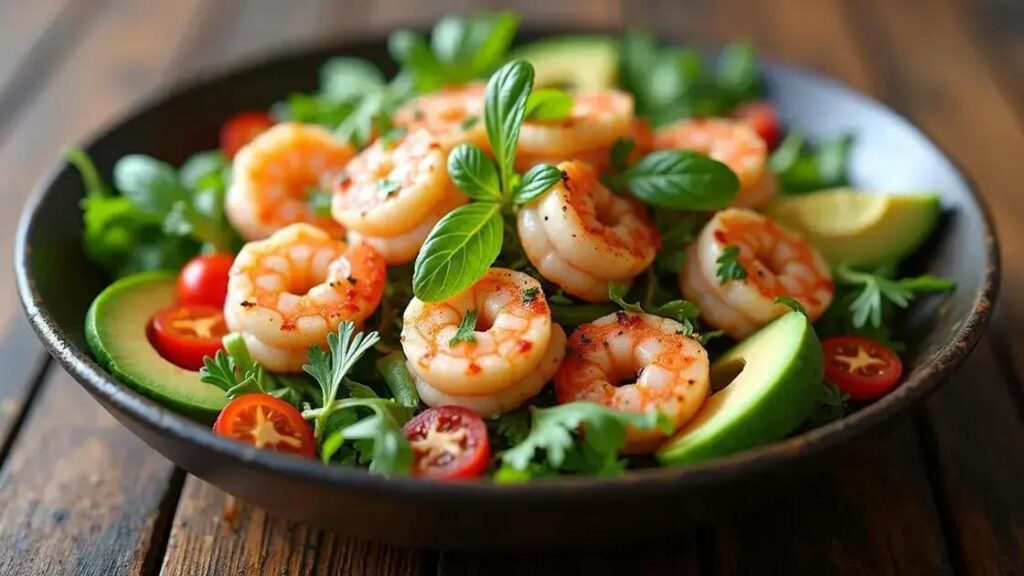The shrimp and avocado salad is a nutritious meal ideal for men over 50, offering health benefits such as high protein, healthy fats, and essential vitamins. Packed with flavor and easy to prepare, this dish supports heart health and muscle maintenance while being low in carbohydrates. Store leftovers in an airtight container and enjoy fresh garnishing for best results.
Preparing a shrimp and avocado salad for men over 50 can be both nutritious and delightful. With ingredients like fresh shrimp and ripe avocados, this salad offers a burst of flavors along with health benefits that are crucial for maintaining a balanced diet. Read on to discover how to make this delicious salad, its benefits, and tips for keeping it fresh.
Benefits of Shrimp and Avocado for Health
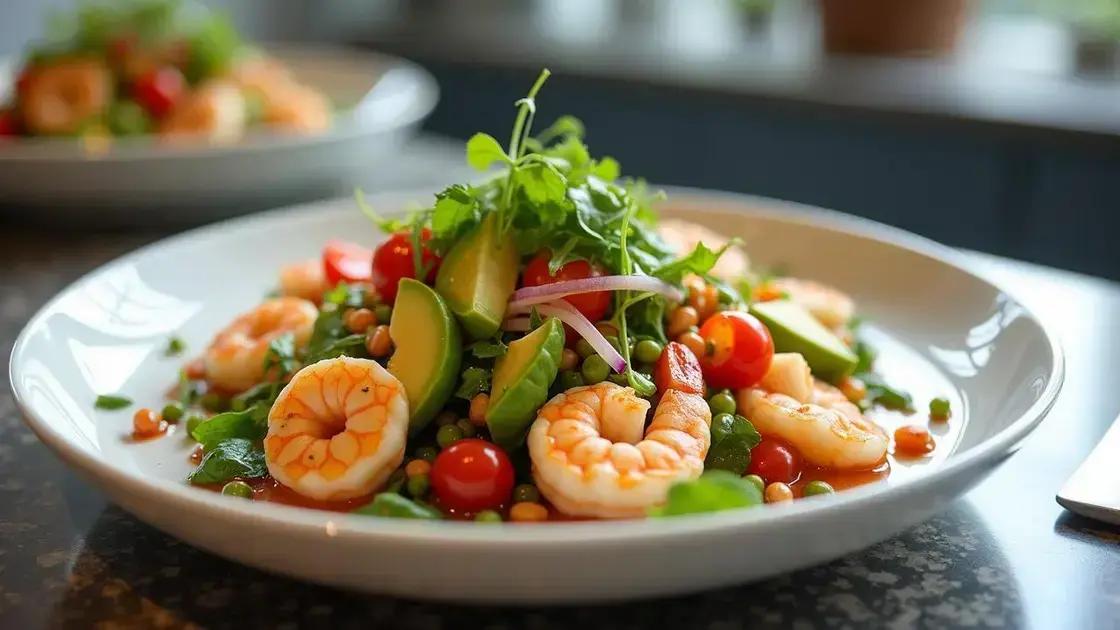
Benefits of Shrimp and Avocado for Health
Shrimp and avocado are not only delicious but also packed with health benefits that are especially important for men over 50. Shrimp is a low-calorie protein source that supports muscle health which tends to decline with age. It is rich in omega-3 fatty acids, which are essential for heart health. Eating shrimp regularly can help lower the risk of heart disease.
Avocado, on the other hand, is loaded with vitamins and minerals. It provides potassium, which helps regulate blood pressure, and contains healthy fats that can improve cholesterol levels. Vitamin E found in avocados also plays a crucial role in maintaining eyesight and supports overall health.
Combining shrimp and avocado in a salad offers a delightful mix of textures and flavors, while delivering nutritional benefits. The antioxidants in avocados work alongside the protein in shrimp to help protect your cells from damage caused by aging.
Additionally, this combination supports digestive health. The fiber in avocado helps maintain gut health, while shrimp is easily digestible. Together, they create a meal that is not only satisfying but also revitalizing.
In summary, incorporating shrimp and avocado into your diet is an excellent choice. They provide essential nutrients that support heart health, muscle maintenance, and overall well-being—key factors for men over 50 looking to enhance their lifestyle.
Step-by-Step Guide to Making the Salad
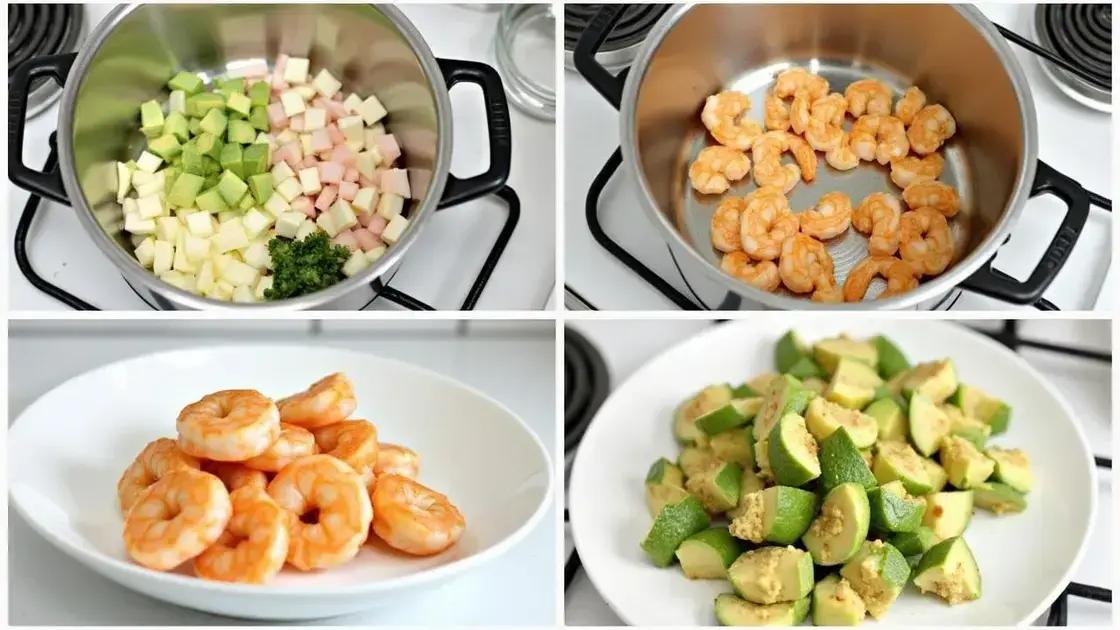
Step-by-Step Guide to Making the Salad
Making a shrimp and avocado salad is simple and quick. Follow these easy steps to create a delicious and healthy dish that men over 50 will love.
Ingredients Needed
- 1 pound of shrimp, peeled and deveined
- 2 ripe avocados, diced
- 1 cup cherry tomatoes, halved
- ¼ cup red onion, finely chopped
- 2 tablespoons fresh lime juice
- 2 tablespoons olive oil
- Salt and pepper to taste
- Fresh cilantro for garnish
Step 1: Cook the Shrimp
Start by cooking the shrimp. In a medium-sized pot, bring water to a boil. Add the shrimp and cook for about 2-3 minutes, or until they turn pink. Remove from heat and drain the shrimp. Allow them to cool.
Step 2: Prepare the Vegetables
While the shrimp cools, prepare the vegetables. In a large bowl, combine the diced avocados, halved cherry tomatoes, and chopped red onion. Mix gently to avoid mashing the avocados.
Step 3: Combine Ingredients
Once the shrimp has cooled, add it to the bowl with the vegetables. Drizzle with lime juice and olive oil. Season with salt and pepper to taste. Stir gently to combine all ingredients while keeping the avocados intact.
Step 4: Serve and Enjoy
Transfer the salad to a serving dish. Garnish with fresh cilantro for added flavor. This salad can be served immediately or chilled for a refreshing taste. It’s a perfect meal for a healthy lifestyle!
Nutritional Information for Men Over 50
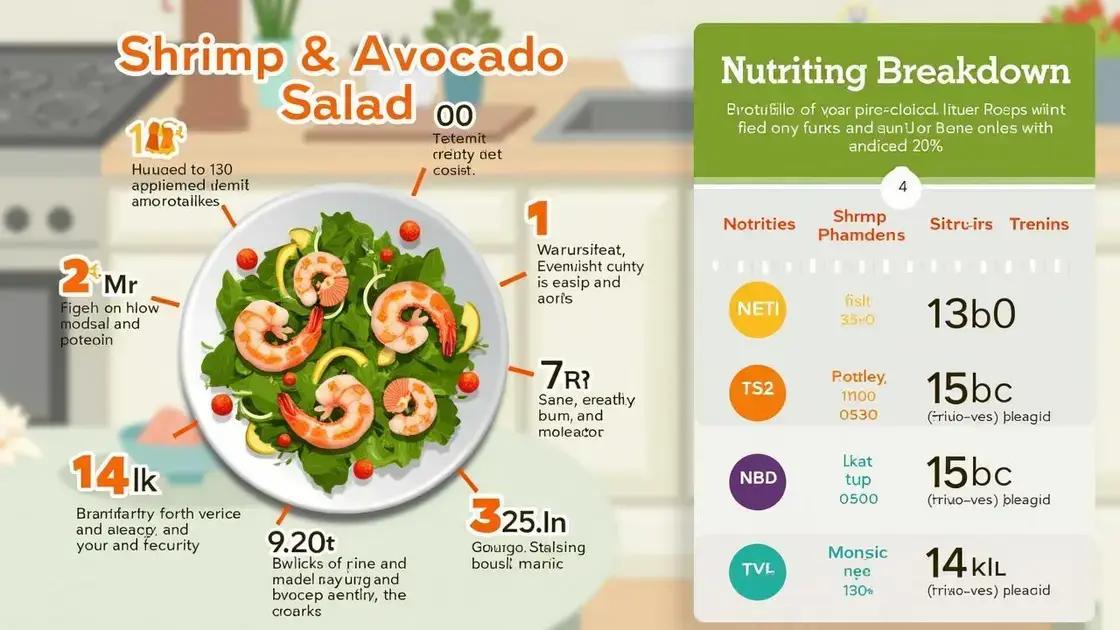
Nutritional Information for Men Over 50
Understanding the nutritional content of your meals is crucial, especially for men over 50. This shrimp and avocado salad is not only tasty but also packed with essential nutrients that support health.
Nutritional Breakdown
- Calories: Approximately 350 calories per serving
- Protein: Contains about 25 grams of protein, contributing to muscle maintenance
- Fats: Healthy fats from avocados, around 20 grams, mostly monounsaturated
- Carbohydrates: Low in carbs, about 15 grams, making it a great option for weight management
- Fiber: Provides 9 grams of dietary fiber which aids digestion and keeps you feeling full
- Vitamins: Rich in vitamins C, E, and K from avocados and tomatoes, essential for immune function and skin health
- Minerals: Good source of potassium, important for heart health and blood pressure regulation
Importance of Each Nutrient
Protein is particularly beneficial for maintaining muscle mass as you age. Including shrimp in your diet helps provide high-quality protein without too many calories. The healthy fats in avocado support heart health and can help reduce cholesterol levels.
Additionally, the fiber in this salad promotes digestive health, which is vital as metabolism slows down with age. The vitamins and minerals found in the ingredients are crucial for overall health, aiding in recovery and maintaining energy levels throughout the day.
Tips for Storing and Serving the Salad
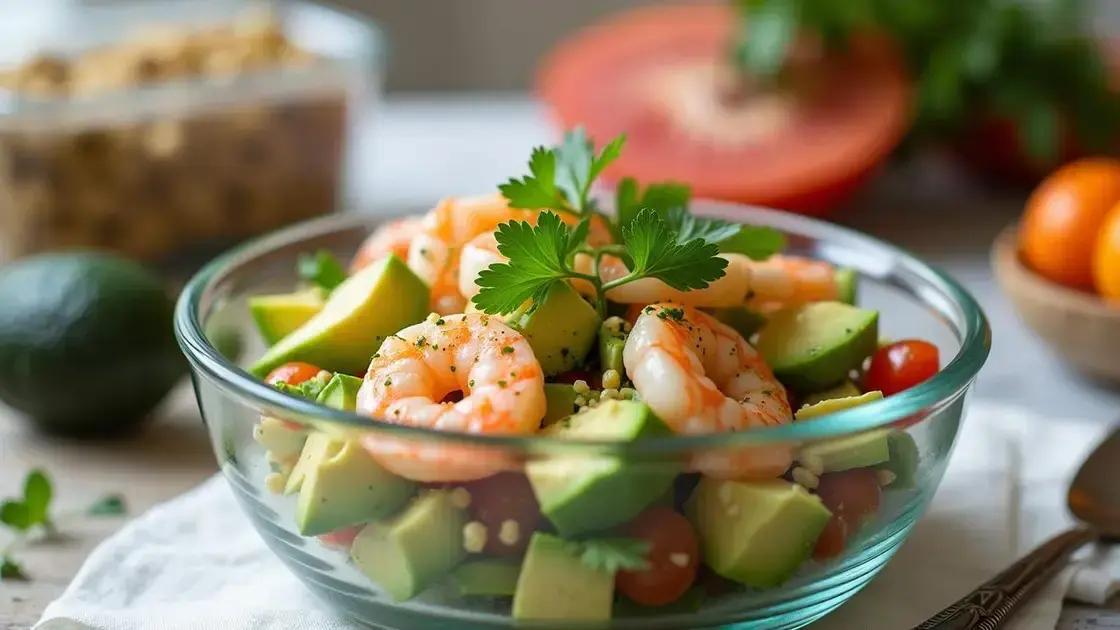
Tips for Storing and Serving the Salad
Properly storing and serving your shrimp and avocado salad can help maintain its freshness and flavor. Here are some practical tips:
Storing the Salad
- Use an Airtight Container: After preparing the salad, transfer it to an airtight container. This keeps the ingredients fresh and prevents them from drying out.
- Refrigerate Promptly: Store the salad in the refrigerator within two hours of preparation. This helps prevent bacterial growth, especially with seafood.
- Limit Storage Time: Consume the salad within 1-2 days. The avocado can brown quickly, so it’s best to eat it fresh.
Serving Suggestions
- Toss Before Serving: Give the salad a gentle toss just before serving to mix the ingredients and dressing evenly.
- Chill for Flavor: If you prefer, let the salad chill in the fridge for 30 minutes before serving. This can enhance the flavors.
- Garnish for Presentation: Add fresh herbs like cilantro or parsley on top for a vibrant look and added flavor when serving.
Pairing with Other Dishes
This salad pairs well with whole grain bread or a light soup, making it a great light meal. It can also be served as a side dish alongside grilled fish or chicken for an extra protein boost.
Final Thoughts on Preparing a Shrimp and Avocado Salad
Preparing a shrimp and avocado salad is a fantastic way to enjoy delicious flavors while providing essential nutrients that are great for men over 50. With the right ingredients and simple steps, you can create a meal that is not only healthy but also satisfying.
By understanding the benefits of shrimp and avocado, knowing how to make the salad, and following the nutritional information, you can enhance your overall diet and well-being.
Remember to store and serve your salad properly to maintain its freshness and flavor. Incorporating this dish into your meal rotation can be a delightful and health-conscious choice.
Take advantage of this nutritious recipe and enjoy the benefits it brings to your lifestyle!
FAQ – Frequently Asked Questions About Preparing a Shrimp and Avocado Salad
What are the health benefits of shrimp and avocado for men over 50?
Shrimp and avocado provide high-quality protein, healthy fats, and essential vitamins that support heart health, muscle maintenance, and overall well-being.
How should I store leftover shrimp and avocado salad?
Store the salad in an airtight container in the refrigerator. It is best consumed within 1-2 days to maintain freshness.
Can I prepare the salad in advance?
Yes, you can prepare the salad in advance, but consider adding avocado just before serving to prevent browning.
What are some serving suggestions for shrimp and avocado salad?
This salad can be served as a main dish, or as a side with grilled meats or seafood. Garnish with fresh herbs for added flavor.
What is the nutritional value of shrimp and avocado salad?
A serving typically contains around 350 calories, 25 grams of protein, and 20 grams of healthy fats, making it a nutritious choice.
Can I modify the recipe to include other ingredients?
Absolutely! You can add other vegetables like cucumber or bell peppers, or include ingredients like quinoa for added texture and nutrition.

